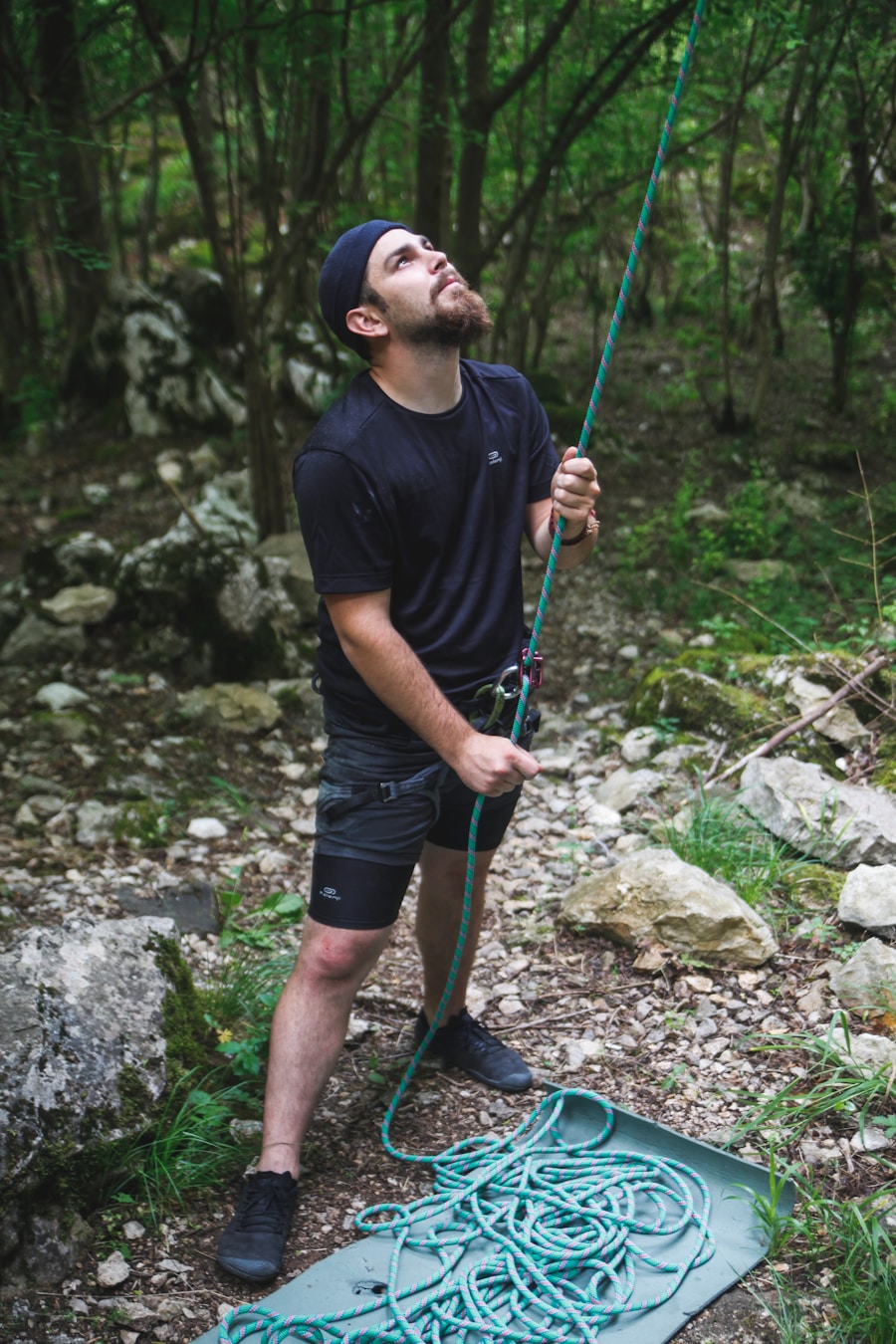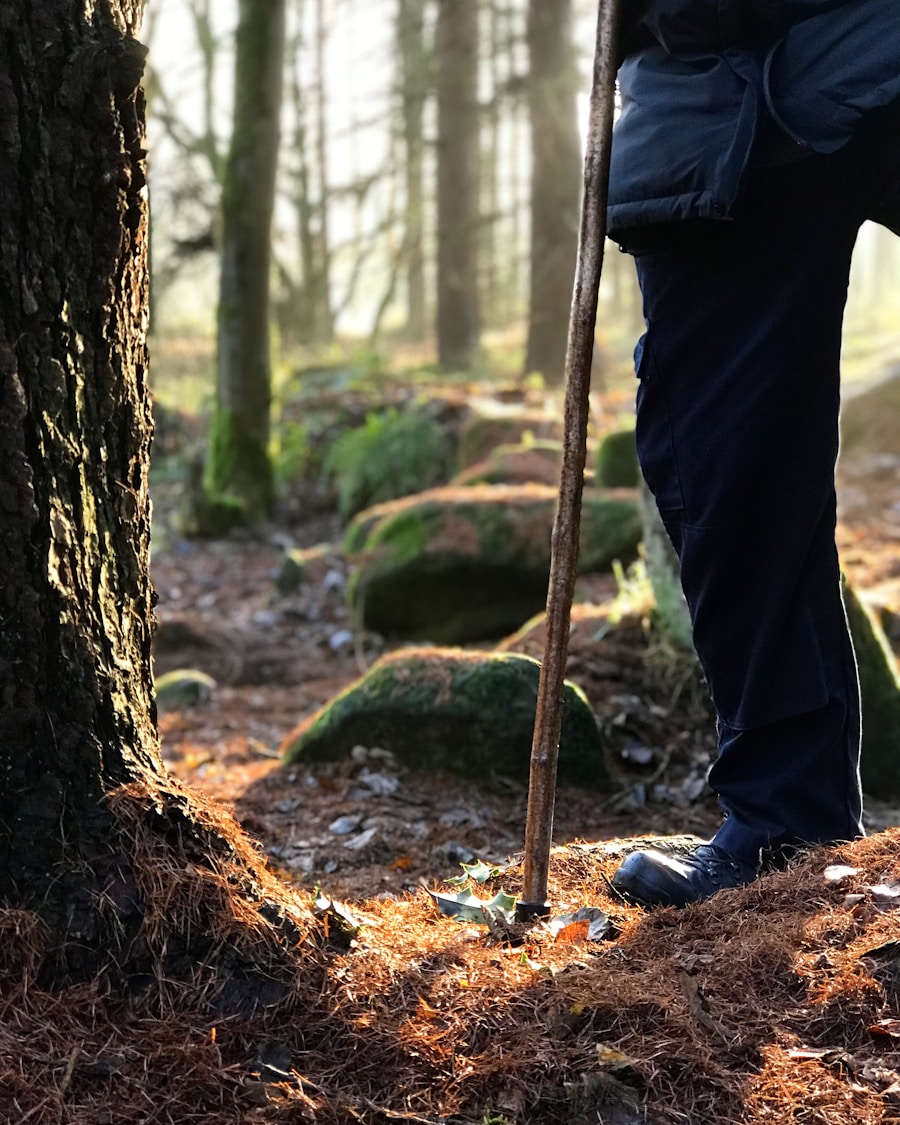Selecting the appropriate walking stick is a crucial first step for anyone looking to enhance their hiking experience. The market offers a plethora of options, ranging from traditional wooden sticks to modern, lightweight aluminum or carbon fiber models. When choosing a walking stick, it is essential to consider factors such as weight, material, and adjustability.
For instance, aluminum sticks are known for their durability and resistance to corrosion, making them ideal for wet conditions. On the other hand, carbon fiber sticks are lighter and provide excellent shock absorption, which can be beneficial during long hikes. Another important aspect to consider is the grip of the walking stick.
Ergonomic grips made from materials like cork or foam can significantly enhance comfort during extended use. A good grip will reduce hand fatigue and provide better control over the stick. Additionally, the length of the walking stick should be adjustable to accommodate different heights and preferences.
A general rule of thumb is that when standing upright, the handle of the stick should reach the wrist when the arm is relaxed at the side. This ensures optimal support and balance while navigating various terrains.
Key Takeaways
- When choosing a walking stick, consider the material, weight, and grip to ensure it is comfortable and suitable for your needs.
- Proper technique for using walking sticks involves holding them at a 90-degree angle, planting them slightly ahead of you, and using them to support your weight as you walk.
- Adjust walking sticks for different terrains by lengthening them for uphill climbs and shortening them for downhill descents to maintain balance and stability.
- Using walking sticks while hiking can reduce strain on the knees, improve balance, and provide additional support on uneven terrain.
- Common mistakes to avoid when using walking sticks include gripping them too tightly, using them at the wrong length, and relying too heavily on them for support.
Proper Technique for Using Walking Sticks
Coordinated Movement
The fundamental principle is to use the sticks in a coordinated manner with your legs. As you step forward with your right foot, the left stick should move forward simultaneously, and vice versa. This alternating motion mimics a natural walking pattern and helps maintain balance, especially on uneven surfaces.
Proper Posture
It is essential to keep your elbows slightly bent and your wrists straight to avoid unnecessary strain. This will help you maintain a comfortable and efficient walking posture.
Techniques for Uphill and Downhill Walking
When traversing uphill or downhill, the technique slightly changes. While ascending, it is advisable to plant the sticks firmly into the ground ahead of you to provide additional leverage and stability. This technique allows you to push off with your arms, reducing the strain on your legs. Conversely, when descending, placing the sticks in front of you can help control your descent and prevent falls. Additionally, engaging your core muscles while using walking sticks can also enhance stability and reduce fatigue over long distances.
Adjusting Walking Sticks for Different Terrains

Different terrains present unique challenges that require adjustments in how walking sticks are used. For rocky or uneven ground, a shorter stick length may provide better control and stability. Conversely, when hiking on flat or smooth surfaces, extending the sticks can help maintain a natural arm swing and promote a more efficient stride.
Many modern walking sticks come with quick-adjust mechanisms that allow hikers to easily modify their length on the go, which is particularly useful when transitioning between different types of terrain. In addition to adjusting length, hikers should also consider the type of tips on their walking sticks. Rubber tips are excellent for providing traction on hard surfaces like pavement or packed dirt trails, while carbide tips are better suited for rocky or loose terrain as they dig into the ground for better grip.
Some walking sticks even come with interchangeable tips that can be swapped out depending on the conditions, allowing for greater versatility during hikes.
Benefits of Using Walking Sticks while Hiking
| Benefits of Using Walking Sticks while Hiking |
|---|
| 1. Improved Stability |
| 2. Reduced Impact on Joints |
| 3. Increased Endurance |
| 4. Enhanced Balance |
| 5. Better Posture |
| 6. Aid in Uphill and Downhill Climbing |
| 7. Additional Support on Uneven Terrain |
The advantages of using walking sticks while hiking extend beyond mere convenience; they can significantly enhance overall hiking performance and safety. One of the primary benefits is improved stability and balance. Walking sticks provide an additional point of contact with the ground, which can be particularly helpful on steep or uneven trails.
This added stability can reduce the risk of falls and injuries, making hiking more accessible for individuals of varying fitness levels. Moreover, walking sticks can alleviate stress on joints, particularly in the knees and hips. By distributing weight more evenly across the body, they help reduce the impact on these critical areas during descents or when carrying heavy packs.
Studies have shown that using walking sticks can decrease joint strain by up to 25%, making them an invaluable tool for those with pre-existing joint issues or those who are prone to fatigue during long hikes. Additionally, they can enhance endurance by allowing hikers to engage their upper body muscles, providing a full-body workout rather than just relying on leg strength.
Common Mistakes to Avoid when Using Walking Sticks
While walking sticks can be incredibly beneficial, there are common mistakes that hikers often make that can negate their advantages. One prevalent error is using walking sticks that are not properly adjusted for height. If the sticks are too long or too short, they can lead to poor posture and increased fatigue.
Hikers should take the time to adjust their sticks before setting out on a hike to ensure they are at an appropriate length for their height and the terrain. Another mistake is failing to use both sticks effectively. Some hikers may rely solely on one stick, which can lead to imbalances and increased strain on one side of the body.
It is essential to use both sticks in a coordinated manner to maximize stability and support. Additionally, many hikers overlook the importance of maintaining a relaxed grip on the handles; gripping too tightly can lead to hand fatigue and discomfort over time.
Maintaining and Caring for Walking Sticks

Proper maintenance of walking sticks is essential for ensuring their longevity and performance. Regularly inspecting the sticks for signs of wear or damage is crucial; this includes checking for cracks in the shaft, wear on the tips, or issues with locking mechanisms. If any damage is detected, it is advisable to address it promptly to prevent further deterioration or failure during use.
Cleaning walking sticks after each hike can also extend their lifespan significantly. Dirt and debris can accumulate in joints and mechanisms, leading to corrosion or malfunction over time. A simple wipe down with a damp cloth followed by thorough drying can help maintain their condition.
For wooden walking sticks, applying a wood conditioner periodically can prevent cracking and preserve their appearance.
Incorporating Walking Sticks into Your Hiking Routine
Integrating walking sticks into your hiking routine can enhance not only your performance but also your enjoyment of outdoor activities. For beginners, it may be beneficial to start with shorter hikes while getting accustomed to using walking sticks effectively. Gradually increasing distance and difficulty will allow you to develop confidence in your technique and understand how best to utilize them in various conditions.
In addition to physical benefits, using walking sticks can also encourage mindfulness during hikes. The rhythmic motion of planting the sticks can create a meditative quality to your experience, allowing you to connect more deeply with nature. Many hikers find that using walking sticks helps them maintain a steady pace, which can enhance endurance and make longer hikes more manageable.
Safety Tips for Using Walking Sticks on the Trail
Safety should always be a priority when using walking sticks on hiking trails. One key tip is to remain aware of your surroundings at all times; this includes being mindful of other hikers, wildlife, and potential hazards such as loose rocks or slippery surfaces. When approaching steep descents or tricky sections of trail, it’s wise to slow down and take extra care in placing your sticks securely before taking each step.
Additionally, it’s important to know when not to use walking sticks. In certain situations—such as crossing streams or navigating very narrow paths—having both hands free may be more advantageous than relying on sticks for support. Understanding when to adapt your technique based on environmental conditions will enhance both safety and enjoyment during your hikes.
Always remember that while walking sticks are valuable tools for enhancing stability and reducing strain, they should complement your natural abilities rather than replace them entirely.
If you’re planning a hiking trip and looking to improve your experience by using walking sticks, you may want to check out this article on the best time to travel to Utah. Utah offers a variety of stunning hiking trails, and having the right gear like walking sticks can make your journey more enjoyable and safe. This guide will help you plan your trip to Utah at the perfect time of year to make the most of your hiking adventure.
FAQs
What are the benefits of using walking sticks while hiking?
Using walking sticks while hiking can provide several benefits, including improved stability and balance, reduced strain on the knees and lower body, increased power and endurance, and added support when navigating uneven terrain.
How do you choose the right walking sticks for hiking?
When choosing walking sticks for hiking, consider factors such as the material (aluminum, carbon fiber, or wood), the type of grip (cork, foam, or rubber), the locking mechanism (twist lock or lever lock), and the length that suits your height and the type of terrain you’ll be hiking on.
How should walking sticks be adjusted for hiking?
To adjust walking sticks for hiking, start by setting the length so that your elbows are at a 90-degree angle when holding the grips. Make sure the locking mechanism is secure, and adjust the wrist straps so that they provide support without being too tight.
What is the proper technique for using walking sticks while hiking?
When using walking sticks while hiking, hold them with a relaxed grip, plant them slightly ahead and to the side of your body, and use a natural swinging motion to propel yourself forward. Make sure to adjust the length of the walking sticks based on the terrain and incline.
How can walking sticks be maintained for optimal performance?
To maintain walking sticks for optimal performance, regularly check the locking mechanisms for tightness, clean the grips and shafts to remove dirt and debris, and store them in a dry place when not in use. Inspect the tips for wear and replace them as needed.
